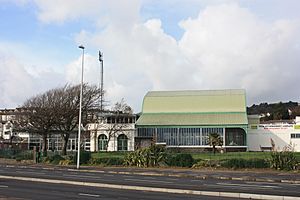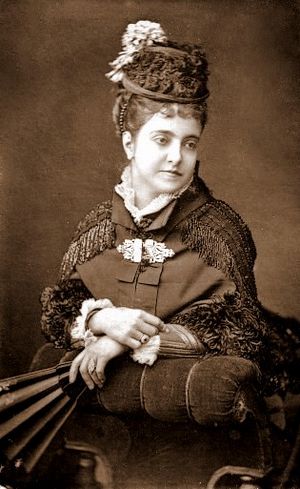Craig-y-Nos Castle facts for kids
| Craig-y-nos Castle | |
Quick facts for kids  Craig-y-nos Castle in 2011 |
|
| Hotel facts and statistics | |
|---|---|
| Location | Swansea Valley, Powys, Wales |
| Coordinates | 51°49′30.00″N 3°41′03.00″W / 51.8250000°N 3.6841667°W |
Craig-y-nos Castle is a large, fancy house built like a Scottish castle. Its name means "Rock of the Night" in Welsh. You can find it near Glyntawe in Powys, Wales.
The castle sits in beautiful parkland next to the River Tawe. It is on the edge of the Black Mountain. A famous opera singer named Adelina Patti once owned this amazing place. Today, Craig-y-nos Castle is a hotel. Its lovely gardens are now a country park for everyone to enjoy. The castle is a very important historical building, known as a Grade II* listed building. Its special theatre has an even higher Grade I listing.
Contents
History of Craig-y-nos Castle
Building the Castle
The Powell Family's Home
The main part of Craig-y-nos Castle was built between 1841 and 1843. Captain Rhys Davies Powell had it built, following designs by Thomas Henry Wyatt. After Captain Powell and his children passed away, his daughter Sarah inherited the estate. She later sold it in 1875.
Morgan Morgan Buys the Estate
In 1876, a man named Morgan Morgan bought the estate for £6,000. He and his family lived in the castle for several years. They cleared many old fir trees that grew between the castle and the nearby quarries. People said these trees were home to local red squirrels.
Adelina Patti's Grand Home
Adelina Patti, a world-famous opera singer, bought Craig-y-nos Castle in 1878. She paid £3,500 for the castle and its surrounding land. Patti wanted to make it her own private estate. She spent most of her life at Craig-y-nos, only leaving to sing in famous opera houses or tour the United States.
After she married her second husband, Ernesto Nicolini, Patti started a big building project. She added new parts to the castle, like the North and South wings. She also built a clock tower, a conservatory, a winter garden, and a special theatre. Patti made her last public appearance in 1914, singing for the Red Cross. She then lived out her life at Craig-y-nos with her third husband.
Adelina Patti Theatre: A Private Opera House
The Adelina Patti Theatre is a very important building, listed as Grade I. Patti had it built as her own private opera house. Architects Bucknall and Jennings designed it, with ideas from Sir Henry Irving. Patti wanted it to be a smaller version of La Scala in Milan. It also has features from other famous opera houses.
The theatre is about 40 feet long, 26 feet wide, and 24 feet high. It was originally decorated in pale blue, cream, and gold. Ten tall Corinthian columns hold up the ceiling. Between these columns are the names of famous composers like Mozart and Verdi. The stage once had blue silk curtains. A special backdrop showed Patti riding in a chariot, dressed as a character from an opera.
This theatre had a clever mechanical floor. It could be raised to be flat for a ballroom. Or it could be sloped towards the stage for theatre performances. An organ, given to Patti after a tour, was also part of the theatre. However, it was taken apart in the 1920s when the castle became a hospital.
The theatre could seat 150 people. Domestic staff would sit in a gallery at the back to watch the shows. The orchestra pit, where musicians played, could hold up to 24 people.
The theatre opened on July 12, 1891, with a grand event. Important guests, including ambassadors and newspaper journalists, attended. Patti herself performed parts of famous operas. After the show, there was a big supper with lots of champagne.
Today, the theatre looks much like it did back then. Its stage equipment is probably the only original 19th-century backstage equipment still existing. The opera house is now used for weddings.
The Winter Garden

The winter garden was a beautiful building made mostly of glass. It had two wrought iron water fountains shaped like cranes. A local ironworker named Mr. Crane made these decorative fountains.
After World War I in 1918, Patti gave her winter garden to the people of Swansea. It became known as the Patti Pavilion. It has been repaired and updated many times since then. One of the crane fountains is still at the castle. The other is in the grounds of Swansea University.
Early Electricity at the Castle
Craig-y-nos was likely the first private house in Wales to have electricity. This was very advanced for the time, as the electric light bulb was only invented a year before. An engine on the grounds made 110-volt DC power. This power lit up Swan lamps throughout the castle. It also powered a special musical instrument called a Welte Concert Orchestrion. This instrument played music using a perforated paper roll. Patti's second husband, Nicolini, loved this organ. This means the electricity was installed before he passed away in 1898.
Patti's Transport
Adelina Patti helped pay for the Neath and Brecon Railway Craig-y-nos railway station. A private road led from the castle to the station. There, Patti had her own fancy waiting room. The railway company also gave her a private railway carriage. She could ask for it to be attached to any train to travel anywhere in the United Kingdom.
At the start of the 20th century, Patti owned one of the first motor cars in Wales. There's a story that she even raced a local doctor from Swansea to Abercrave for a small bet!
Craig-y-nos as a Hospital
After Adelina Patti passed away in 1919, the castle and its grounds were sold. In 1921, the Welsh National Memorial Trust bought it for £11,000. This organization was created to fight tuberculosis (TB) in Wales. The castle was turned into a special hospital called a sanatorium. Patti's widower asked for it to be named the Adelina Patti Hospital. It welcomed its first patients in August 1922.
In 1947, children at Craig-y-nos were among the first in the UK to receive a new medicine for TB, an antibiotic called streptomycin. Later, in 1959, it became a hospital for older people. The castle stopped being a hospital on March 31, 1986. This happened after the remaining patients moved to a new hospital nearby.
A famous rugby player, Clive Rowlands, was a patient there in 1947 when he was eight years old.
Craig-y-nos Today
After closing as a hospital, Craig-y-nos Castle was sold to a group of business people in 1988. They worked to repair and restore the castle. It opened to the public for events, but faced challenges. Later, John and Penelope Jones bought the castle. They continued important repair work, like fixing the theatre roof and installing new heating. They also held antiques fairs, music events, and wedding receptions. In 2000, SelClene Ltd. bought the castle. They continued its restoration and opened it as a hotel.
The castle gardens are also very important, listed as Grade II*.
In 2005, the castle was featured in the BBC show Doctor Who. The episode was called Tooth and Claw. Actors David Tennant and Billie Piper filmed scenes there. The Torchwood crew also stayed at the hotel and filmed some scenes for their episode Countrycide.
Today, Craig-y-nos Castle is a popular place for weddings. It offers rooms for guests and even provides ghost tours. It also welcomes guests who want to bring their dogs.


